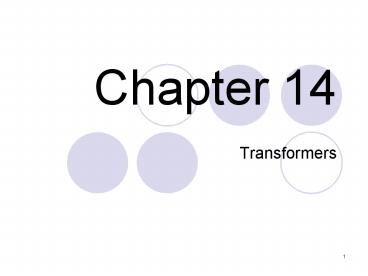Transformers - PowerPoint PPT Presentation
1 / 27
Title:
Transformers
Description:
Transformers. 2. Objectives. Describe the components of an ideal transformer. ... Transformers are designated to be most efficient when operated at full rated ... – PowerPoint PPT presentation
Number of Views:17720
Avg rating:4.0/5.0
Title: Transformers
1
Chapter 14
- Transformers
2
Objectives
- Describe the components of an ideal transformer.
- Explain the relationship among the voltages,
currents, and turns ratio in a transformer. - Calculate the voltage, current, and power in a
transformer.
3
Objectives
- Solve problems involving transformer losses and
demonstrate the effect they have on efficiency. - Show how to connect single-phase transformers to
produce three-phase transformers. - Apply special transformers such as
autotransformers, current transformers, and
potential transformers.
4
14-1 Introduction
5
14-2 The Ideal Transformer
- V1 / V2 N1 / N2
- a NHS / NLS
- V Vrated f / frated
6
Simple transformer.
7
Transformer using high side and low side
designation.
8
14-3 Transformer Power Losses
- Copper Loss
- Core Loss
- Hysteresis Loss
- Eddy Current Loss
9
Copper Loss
- I2R power loss in the copper wire in the
transformer windings. - Proportional to the square of the winding
current. - Minimal when the transformer is operating with no
load. - Maximum copper loss occurs at rated load.
10
Core Loss
- Hysteresis Loss
- Frictional loss caused by the constant change in
magnetic field polarity in the core. - Increases with an increasing voltage or frequency
applied to the transformer windings. - Eddy Current Loss
- I2R loss in the core material caused by
circulating induced currents in the core. - Proportional to the square of the voltage and the
square of the frequency applied to the
transformer windings. - Minimized by laminating the core.
11
14-4 Transformer Efficiency
- ? Pout / Pin
- Pin Pout Plosses
- Plosses Pcu Pcore
12
14-5 Effect of Power Factor on Transformer
Performance
- P V I cos ? V I x P.F.
13
14-6 Impedance Reflection
- RL(HS) a2 RL(LS)
14
Impedance reflection.
15
14-7 Impedance Matching Transformers
- ZHS a2 ZLS
16
14-8 Transformer Construction
- Shell
- Large
- Leakage flux
- E-Core
- Compact
- Leakage flux reduced
17
Cores types, (a) shell and (b) E-core.
18
14-9 Three-Phase Transformers
- Wye-to-Wye
- Wye-to-Delta
- Delta-to-Wye
- Delta-to-Delta
19
Three-phase transformer wye and delta connection
possibilities.
20
14-10 Autotransformers
- When wired as an autotransformer, the maximum
current capacity of any winding of a transformer
is the same as when it is used as a conventional
transformer. - The voltages, currents, and turns ratio still
conform to the equations given. - Although the autotransformer can deliver more
apparent power (S, in volt-amperes) than the
transformer alone, the transformer itself cannot
safely deliver more apparent power than its
rating. - Because autotransformers can be connected in
several different ways, rather than attempt to
memorize the equations used to analyze each, it
is easier to gain a fundamental understanding of
how a basic autotransformer operates and then
develop the governing equations as needed.
21
Autotransformer (boost connection).
22
Autotransformer voltages and currents.
23
Autotransformer buck configuration.
24
Variable autotransformer.
25
14-11 Instrument Transformers
- Potential Transformer
- Current Transformer
26
Potential transformer and current transformer
application.
27
14-12 Useful Transformer Tips
- The core losses in a transformer are determined
by the applied voltage and frequency. Winding
currents have no bearing on core loss. Reducing
the load on a transformer will not reduce its
core loss. - The copper losses in a transformer are
proportional to the squares of the winding
currents and the square of the frequency. The
applied voltage has no bearing on the copper
loss. - The maximum current that can be carried safely by
a transformer winding is determined only by the
wire gauge of the windings. The dimensions of
the core and applied voltage have no bearing on
maximum current capacity. Operating a
transformer at a reduced voltage will not change
its maximum current capability. - The real power (watts) that can be delivered
safely by a transformer is the volt-amp rating of
a transformer times the power factor of the load
it is powering. For example, a 1-kVA transformer
can deliver only 700 watts to a 0.7-power-factor
load. - Transformers are designated to be most efficient
when operated at full rated load (that is, rated
voltage and rated current). Operating a
transformer at reduced load current or reduced
voltage reduces its efficiency. - Transformers may be operated at lower frequencies
if their voltage and apparent power ratings are
derated by the same ratio as the frequency
reduction.































